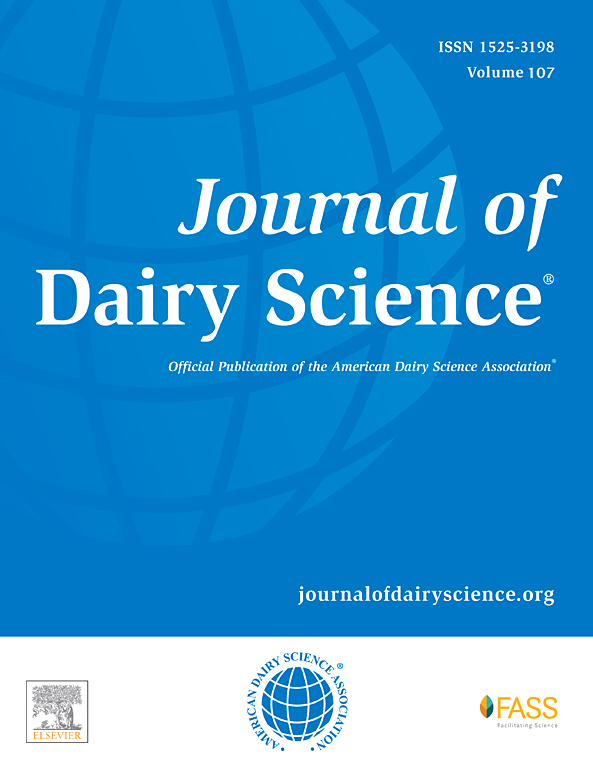Machine learning methods for unveiling the potential of antioxidant short peptides in goat milk-derived proteins during in vitro gastrointestinal digestion
IF 3.7
1区 农林科学
Q1 AGRICULTURE, DAIRY & ANIMAL SCIENCE
引用次数: 0
Abstract
Milk serves as an important dietary source of bioactive peptides, offering notable benefits to individuals. Among the antioxidant short peptides (di- and tripeptides) generated from gastrointestinal digestion are characterized by enhanced bioavailability and bioaccessibility, while assessing them individually presents a labor-intensive and expensive challenge. Based on 4 distinct types of AA descriptors (physicochemical, 3-dimensional structural, quantum, and topological attributes) and genetic algorithms for feature selection, 1 and 4 machine learning–predicted models separately for di- and tripeptides with 2,2-azinobis(3-ethylbenzothiazoline-6-sulfonic acid) diammonium salt radical scavenging capacity exhibited excellent fitting and prediction ability with random forest regression as machine learning algorithm. Intriguingly, the electronic properties of N-terminal AA were considered as only factor affecting the antioxidant capacity of dipeptides containing both tyrosine and tryptophan. Four peptides from the potential di- and tripeptides exhibited highly predicted values by the constructed predicted models. Subsequently, a total of 45 dipeptides and 52 tripeptides were screened by a customized workflow in goat milk during in vitro simulated digestion. In addition to 5 known antioxidant dipeptides, 9 peptides were quantified during digestion, exhibiting concentrations ranging from 0.04 to 1.78 mg L−1. Particularly noteworthy was the promising in vivo functionality of antioxidant dipeptides with N-terminal tyrosine, supported by in silico assays. Overall, this investigation explored crucial molecular properties influencing antioxidant short peptides and high-throughput screening potential peptides with antioxidant activity from goat milk aided by machine learning, thereby facilitating the discovery of novel functional peptides from milk-derived proteins and paving the way for understanding their metabolites during digestion.
在体外胃肠道消化过程中揭示山羊奶衍生蛋白质中抗氧化短肽潜力的机器学习方法。
牛奶是生物活性肽的重要膳食来源,对人体有显著的益处。在胃肠道消化产生的抗氧化短肽(二肽和三肽)中,生物利用率和生物可及性都有所提高,而对它们进行单独评估则是一项劳动密集型且成本高昂的挑战。基于 4 种不同类型的氨基酸描述符(理化、三维结构、量子和拓扑属性)和遗传算法进行特征选择,以随机森林回归作为机器学习算法,对具有 ABTS 自由基清除能力的二肽和三肽分别建立了 1 个和 4 个机器学习预测模型,表现出卓越的拟合和预测能力。有趣的是,N 端氨基酸的电子特性被认为是影响含酪氨酸和色氨酸二肽抗氧化能力的唯一因素。在构建的预测模型中,潜在的二肽和三肽中有四种肽的预测值很高。随后,在体外模拟消化过程中,采用定制的工作流程在山羊奶中筛选出了45种二肽和52种三肽。除了 5 种已知的抗氧化二肽外,还对 9 种肽进行了消化定量,其含量范围在 0.04 至 1.78 mg L-1 之间。尤其值得注意的是,在硅学检测的支持下,N-末端为酪氨酸的抗氧化二肽在体内具有良好的功能性。总之,这项研究探索了影响抗氧化短肽的关键分子特性,并在机器学习的辅助下从山羊奶中高通量筛选出了具有抗氧化活性的潜在短肽,从而促进了从牛奶衍生蛋白质中鉴定新型生物活性肽的工作,并为了解它们在消化过程中的代谢产物铺平了道路。
本文章由计算机程序翻译,如有差异,请以英文原文为准。
求助全文
约1分钟内获得全文
求助全文
来源期刊

Journal of Dairy Science
农林科学-奶制品与动物科学
CiteScore
7.90
自引率
17.10%
发文量
784
审稿时长
4.2 months
期刊介绍:
The official journal of the American Dairy Science Association®, Journal of Dairy Science® (JDS) is the leading peer-reviewed general dairy research journal in the world. JDS readers represent education, industry, and government agencies in more than 70 countries with interests in biochemistry, breeding, economics, engineering, environment, food science, genetics, microbiology, nutrition, pathology, physiology, processing, public health, quality assurance, and sanitation.
 求助内容:
求助内容: 应助结果提醒方式:
应助结果提醒方式:


